AMD Athlon 64 4000+ & FX-55: A Thorough Investigation
by Anand Lal Shimpi on October 19, 2004 1:04 AM EST- Posted in
- CPUs
Workstation Applications
Visual Studio 6
Carried over from our previous CPU reviews, we continue to use Visual Studio 6 for a quick compile test. We are still using the Quake 3 source code as our test and measure compile time in seconds. The results are pretty much in line with what we've seen in the past.
Without compiler speed optimizations for NetBurst, the Pentium 4 architecture is not very well suited for highly branchy applications such as compiling and code optimization. The Athlon 64 is far better suited for this type of usage pattern and thus AMD wins the compiler test.
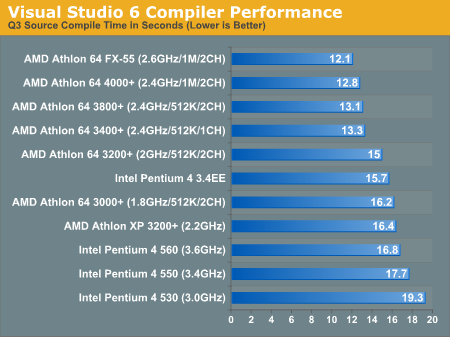
SPECviewperf 8
For our next set of professional application benchmarks we turn to SPECviewperf 8. SPECviewperf is a collection of application traces taken from some of the most popular professional applications, and compiled together in a single set of benchmarks used to estimate performance in the various applications the benchmark is used to model. With version 8, SPEC has significantly improved the quality of the benchmark, making it even more of a real world indicator of performance.
We have included SPEC's official description of each one of the 8 tests in the suite.
3dsmax Viewset (3dsmax-03)
"The 3dsmax-03 viewset was created from traces of the graphics workload generated by 3ds max 3.1. To insure a common comparison point, the OpenGL plug-in driver from Discreet was used during tracing.
The models for this viewset came from the SPECapc 3ds max 3.1 benchmark. Each model was measured with two different lighting models to reflect a range of potential 3ds max users. The high-complexity model uses five to seven positional lights as defined by the SPECapc benchmark and reflects how a high-end user would work with 3ds max. The medium-complexity lighting models uses two positional lights, a more common lighting environment.
The viewset is based on a trace of the running application and includes all the state changes found during normal 3ds max operation. Immediate-mode OpenGL calls are used to transfer data to the graphics subsystem."
The biggest surprise here is that there is a huge performance impact (13%) by moving down to a single channel memory subsystem with the Athlon 64. There are also a couple of other surprises, with the Pentium 4 560 doing surprisingly well, coming in at the heels of the Athlon 64 FX-55.
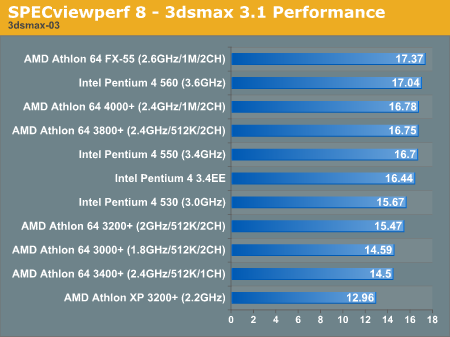
CATIA Viewset (catia-01)
"The catia-01 viewset was created from traces of the graphics workload generated by the CATIATM V5R12 application from Dassault Systemes.
Three models are measured using various modes in CATIA. Phil Harris of LionHeart Solutions, developer of CATBench2003, supplied SPEC/GPC with the models used to measure the CATIA application. The models are courtesy of CATBench2003 and CATIA Community.The car model contains more than two million points. SPECviewperf replicates the geometry represented by the smaller engine block and submarine models to increase complexity and decrease frame rates. After replication, these models contain 1.2 million vertices (engine block) and 1.8 million vertices (submarine).
State changes as made by the application are included throughout the rendering of the model, including matrix, material, light and line-stipple changes. All state changes are derived from a trace of the running application. The state changes put considerably more stress on graphics subsystems than the simple geometry dumps found in older SPECviewperf viewsets.
Mirroring the application, draw arrays are used for some tests and immediate mode used for others."
The single channel Athlon 64 3400+ does exceptionally poorly here, with the dual channel Athlon 64 parts holding a significant performance advantage. By now it's no surprise to see the FX-55, 4000+ and 3800+ at the top of the charts.
Interestingly enough, the CATIA benchmark appears to favor Intel's Prescott core over Northwood.
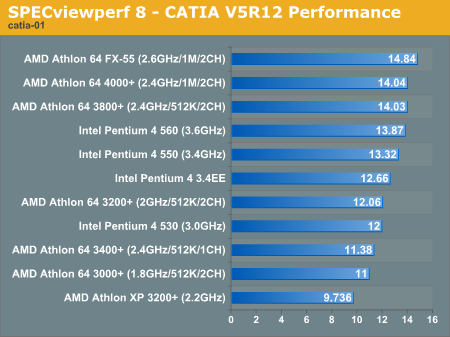
EnSight (ensight-01)
"The ensight-01 viewset replaces the Data Explorer (dx) viewset. It represents engineering and scientific visualization workloads created from traces of CEI's EnSight application.
CEI contributed the models and suggested workloads. Various modes of the EnSight application are tested using both display-list and immediate-mode paths through the OpenGL API. The model data is replicated by SPECviewperf 8.0 to generate 3.2 million vertices per frame.
State changes as made by the application are included throughout the rendering of the model, including matrix, material, light and line-stipple changes. All state changes are derived from a trace of the running application. The state changes put considerably more stress on graphics subsystems than the simple geometry dumps found in older viewsets.
Mirroring the application, both immediate-mode and display-list modes are measured."
No 925X based test system would complete this test, thus all we have are AMD chips to look at. Once again we see that the 3400+ is seriously crippled by its single channel memory interface.
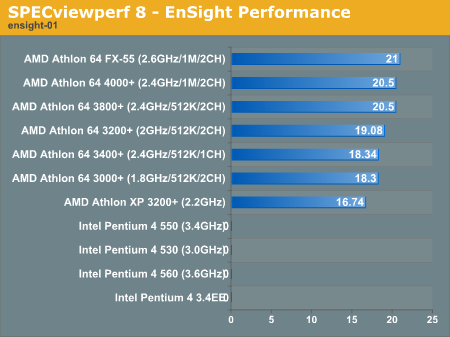
Lightscape Viewset (light-07)
"The light-07 viewset was created from traces of the graphics workload generated by the Lightscape Visualization System from Discreet Logic. Lightscape combines proprietary radiosity algorithms with a physically based lighting interface.
The most significant feature of Lightscape is its ability to accurately simulate global illumination effects by precalculating the diffuse energy distribution in an environment and storing the lighting distribution as part of the 3D model. The resulting lighting "mesh" can then be rapidly displayed."
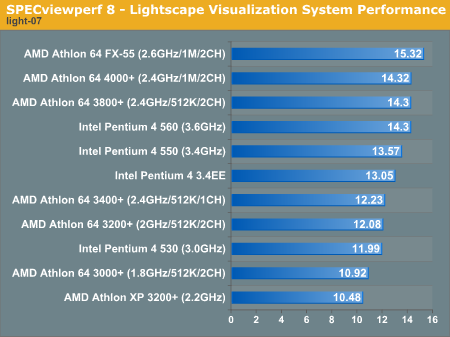
Maya Viewset (maya-01)
"The maya-01 viewset was created from traces of the graphics workload generated by the Maya V5 application from Alias.
The models used in the tests were contributed by artists at NVIDIA. Various modes in the Maya application are measured.
State changes as made by the application are included throughout the rendering of the model, including matrix, material, light and line-stipple changes. All state changes are derived from a trace of the running application. The state changes put considerably more stress on graphics subsystems than the simple geometry dumps found in older viewsets.
As in the Maya V5 application, array element is used to transfer data through the OpenGL API."
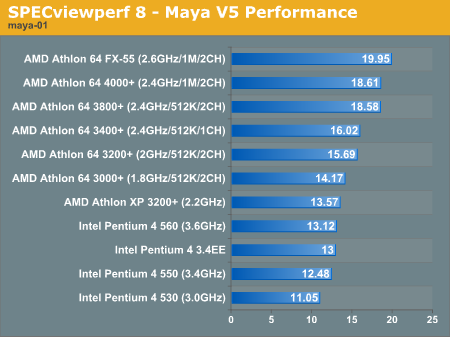
Pro/ENGINEER (proe-03)
"The proe-03 viewset was created from traces of the graphics workload generated by the Pro/ENGINEER 2001TM application from PTC.
Two models and three rendering modes are measured during the test. PTC contributed the models to SPEC for use in measurement of the Pro/ENGINEER application. The first of the models, the PTC World Car, represents a large-model workload composed of 3.9 to 5.9 million vertices. This model is measured in shaded, hidden-line removal, and wireframe modes. The wireframe workloads are measured both in normal and antialiased mode. The second model is a copier. It is a medium-sized model made up of 485,000 to 1.6 million vertices. Shaded and hidden-line-removal modes were measured for this model.
This viewset includes state changes as made by the application throughout the rendering of the model, including matrix, material, light and line-stipple changes. The PTC World Car shaded frames include more than 100MB of state and vertex information per frame. All state changes are derived from a trace of the running application. The state changes put considerably more stress on graphics subsystems than the simple geometry dumps found in older viewsets.
Mirroring the application, draw arrays are used for the shaded tests and immediate mode is used for the wireframe. The gradient background used by the Pro/E application is also included to better model the application workload."
When the Athlon was first released, it was a very solid performer in Pro/ENGINEER. But of course, back then, very few companies would think about Athlon workstations. With the Athlon 64 times have obviously changed, but the performance advantage does not seem to have changed at all, AMD continues to lead the way in the proe-03 viewset.
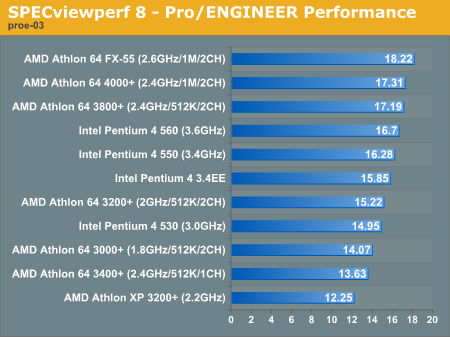
SolidWorks Viewset (sw-01)
"The sw-01 viewset was created from traces of the graphics workload generated by the Solidworks 2004 application from Dassault Systemes.
The model and workloads used were contributed by Solidworks as part of the SPECapc for SolidWorks 2004 benchmark.
State changes as made by the application are included throughout the rendering of the model, including matrix, material, light and line-stipple changes. All state changes are derived from a trace of the running application. The state changes put considerably more stress on graphics subsystems than the simple geometry dumps found in older viewsets.
Mirroring the application, draw arrays are used for some tests and immediate mode used for others."
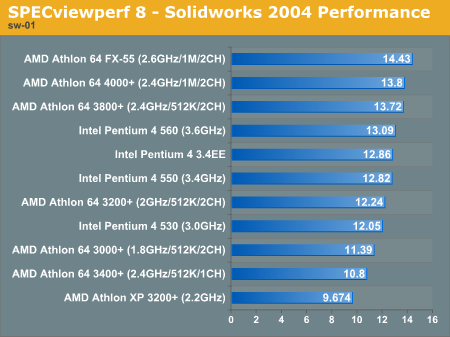
Unigraphics (ugs-04)
"The ugs-04 viewset was created from traces of the graphics workload generated by Unigraphics V17.
The engine model used was taken from the SPECapc for Unigraphics V17 application benchmark. Three rendering modes are measured -- shaded, shaded with transparency, and wireframe. The wireframe workloads are measured both in normal and anti-alised mode. All tests are repeated twice, rotating once in the center of the screen and then moving about the frame to measure clipping performance.
The viewset is based on a trace of the running application and includes all the state changes found during normal Unigraphics operation. As with the application, OpenGL display lists are used to transfer data to the graphics subsystem. Thousands of display lists of varying sizes go into generating each frame of the model.
To increase model size and complexity, SPECviewperf 8.0 replicates the model two times more than the previous ugs-03 test."
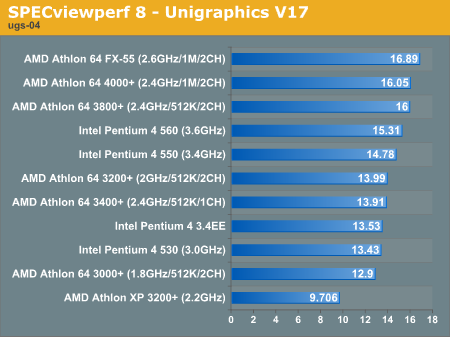










89 Comments
View All Comments
mlittl3 - Wednesday, October 20, 2004 - link
Hey Val, why don't you go to this link and look at a picture of your hero, Intel CEO Craig Barrett on one knee begging forgiveness for their shitty processors.http://news.com.com/Photo+Barretts+mea+culpa/2100-...
Both Intel and AMD have difficulties. But your analogy of AMD being like the cheap car companies doesn't make sense. The expensive car companies like Ferrari, Porsche, etc. sell the best cars but are very small companies because not many can afford them. AMD is like these companies now because they sell the processors for a lot of money because they are really good. Just not everyone can afford them.
But AMD is good for cheap processors too. Please find one review site that shows any Celeron doing better than a Sempron 3100+. Just one site. I want only to see you post that link in your next posting. Nothing else please because every thing you say is wrong and I'm sure Intel fanboys are telling you to stop making them look bad.
Gnoad - Wednesday, October 20, 2004 - link
Eh, let him have his celerons, Intel will need the fan base soon to stay in business come 2005...Rhl - Wednesday, October 20, 2004 - link
First off, Val, you're ignorant. You shouldn't speak on subjects where you are grieviously misinformed, it makes your intelligence quotient seem very low.1. You think Celerons are fast? I'm sorry, what hole have you been living in? A 1.7 ghz Celeron is SLOW, and far outpaced by an Athlon 1.7 ghz. Almost by 2x as much.
2. AMD doesn't design their own processors? May I ask who does then? INTEL? LOL. Sorry, but no, AMD does design all of their own CPU's.
3. They don't care or support consumers/developers etc? OF COURSE THEY DO, AMD's track record of supporting "the little guys" (independent shops, consumers etc) is FAR better than Intel, who doesn't care much at all for the "little guys". What you have stated is just plain WRONG.
4. AMD is alot cheaper than Intel, and is ALOT better as well. They beat Intel in real world benchmarks 9 times out of 10. You think because they're cheaper they're worse? How old are you? You need to do some research, kid.
5. You're right, nobody expects AMD to be as good as Intel... BECAUSE THEY'RE BETTER. AMD is flatout kicking Intel's ass, and has been since the original Athlon was released.
I think, val, that your brain is too "cold down", as you say, and it's not working as well as it should. Go research AMD vs Intel, and check out the realworld benchmarks. If that doesn't change your mind, go buy a Dell, you silly ignorant little fool.
screech - Wednesday, October 20, 2004 - link
#64: celeron=too fast? seems like you haven't owned a celeron......anyway, why pay more for a crappy celeron when AMD can offer more performance for less money? (I am talking about the older celerons, ie 1.7, celeronD isn't that bad although sempron 3100 still wipes the floor with it).AMD only copies intel? where did intel's EMT64 (or whatever its called) come from? realistically both copy each other, although it looks like intel should have done more copying of a shorter pipeline a la AMD, given that the prescott seems to have been a failure. (no 4 ghz).
AMD is cheap, doesn't care for quality? Ladies and gentlemen, seems like Kanavit from THG has decided to start trolling around here...I heard him say that exact same thing a while back over there. anyway, this is such BS that it is hilarious. What kind of flawed logic says that better performance=cheap processors? haha. :D
anti intel BS based on fool snthetic benchmarks? LMAO. I agree that many synthetics are dumb, because often they do not reflect real performance in applications (intel high clocks often win the synthetics but then AMD's processors often win real world benchies), but AMD owns intel in jthe majority of benchmarks. I suppose you consider AMD winning (except for a tie or 2) EVERY gaming benchmark, an "if than" or synthetic? UT2004 is theoretical? it doesnt exist?
on another note, good job discrediting the only benchmarks that intel usually wins--synthetics.
I hope you wake up and smell the coffee.
Gnoad - Wednesday, October 20, 2004 - link
haha, its kinda funny watching someone defend their opinion to the bitter end even though its blatantly wrong and totally misinformed. No offense val, but seriously, you got a lot of reading to do to catch up with the current realities in the CPU world.val - Wednesday, October 20, 2004 - link
#63: i am not ignorant fool and try to control your self a bit.1,7 celeron is pretty old, 3 years or more, but i am sure that for many tasks even this is fast too much. I am sure that if you feel that the mentioned celeron was slow, it was because you was playing on it (what it was not supposed to be for) or rest of system was bad designed (HDD, memory,...)
#61: now i am happy that AMD is here, same as i am happy that there is cheap cars to buy, competing is good for all. i call for even more competitors to drop prices to real level (as in mainboards they are), same for GCs.
What i am trying to tell you, that AMD is only manufacturing what somebody else designs, they dont care and dont support products and developers, dont care for chipsets quality, certificates, nothing. This leads to that overall quality of AMD platform is far from what you can get with similar price based on Intel.
So cold down, AMD is cheap, is supposed to be cheap, nobody expects to be as good as intel with all their background. Stop that anti intel BS which is based on fool synthetic benchmarks and theoretical "if than" visions.
michaelpatrick33 - Wednesday, October 20, 2004 - link
The power consumption graph is wrong because it shows the AMD 3000+ and 3200+ as having dual channel but the power usage shows the same as the 130nm chips. AMD only makes the 3000+ and 3200+ for 939 on 90nm I thought so unless the 90nm 3000+ and 3200+ runs with more power than the faster 3500+ 90nm the graph needs to be changed. Just a stickler sorry.AtaStrumf - Wednesday, October 20, 2004 - link
Vai you need to pull you head out of your ass and smell the air. WTF are you talking about??? Sure AMD has had their share of troubles (who hasn't, Intel certainly has), but saying what your're saying just makes me think you're an ignorant fool.It's exacly that kind of thinking that makes people buy Celerons (I mean it's Intel right, so it can't be bad), and they I have to deal with 1,7 GHz piece of crap like I did yesterday for example. God that is SLOOOOOOOOOW!
mlittl3 - Wednesday, October 20, 2004 - link
#49, #50, #52, #54, #55, #60 (Val)Do you think AMD should go out of business and that Intel should be the only company out there? I am guessing you are from another country so you probably also hate (never seen) an Apple. Do you think no one should choose apple? Do you wish that apple should go out of business? What about Via and Transmeta processors (C3 and Crusoe)? Do you hate those companies too and wish them out of business? Do you think their processors suck?
You talk about choice in your #54 post (I'm assuming you don't know what choice means) yet you want everyone to choose Intel because you don't know how to build a pc properly. If you base your decision not to buy AMD because you've had troubles in the past and you are assumming that everyone will have troubles, then how did AMD make ~$1.25 billion in revenue last quarter? Did they make that money selling lemonade?
Just because a company doesn't have a large presence in whatever country you are from doesn't make them inferior products. I don't know if you have heard the statement that competition drives progress. If AMD, VIA, Transmeta, Apple, IBM, etc. etc. did not exist because Val can't get an AMD system running and demands everyone use Intel, then what motivation does Intel have to bring good products to market? The 1 GHz race is what got Intel to improve its processors and maybe even release the Pentium 4. The addition of 64-bits to AMD and Intel processors got software and hardware companies to start optimizing their products for the new tech. Hell, now with Dual-core being pushed by both companies, multi-threaded apps (and hopefully this will include games) will be developed by software companies as well.
If we had just Intel which I'm assuming you pray was the case everyday, then we would have non-64bit, ~2 Ghz, non-dualcore, non-HT, pentium 3's right now.
You must live under a rock and think AMD is still the company it was back in the early 1990's. Both Intel and AMD are necessary in the market and both of their processors and other products are used by a large number of people. More people use Intel right now and AMD has the right to try and get more people to use them and they are.
What exactly are you trying to tell us?
val - Wednesday, October 20, 2004 - link
58: thank you for information, i use Kingston or infineon on rated values which are properly detected over SPD. Maybe not on mainboards for AMD, i dont know. PSU i use Intel or Enermax with appropriate power. In my HTPC i have some noname, but it runs with no problem.